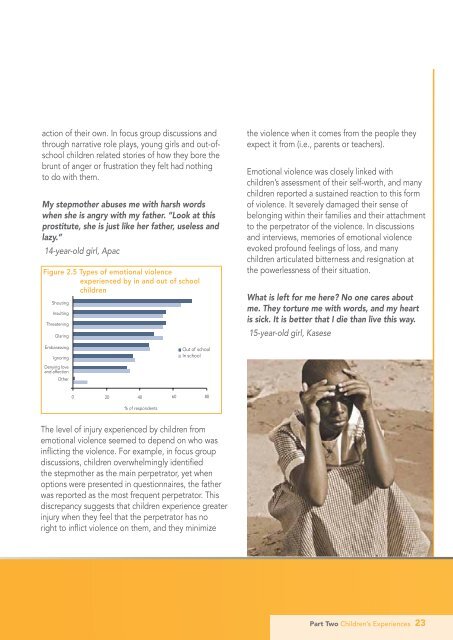QUESTION 3Have you experienced emotional violence?Emotional <strong>Violence</strong>:Any act or interaction in which <strong>the</strong> adultintentionally attacks <strong>children</strong>’s feelings, withholdsaffection from <strong>children</strong>, or undermines <strong>children</strong>’sopinions <strong>of</strong> <strong>the</strong>mselves, and, as a result, adverselyaffects <strong>children</strong>’s self-confidence. 7Figure 2.4 Types <strong>of</strong> emotional violenceexperienced by <strong>children</strong>, as per sex <strong>of</strong>respondentsShoutingInsultingThreateningOf all <strong>the</strong> forms <strong>of</strong> violence reported, <strong>children</strong>talked most emphatically about <strong>the</strong> impact <strong>of</strong>emotional violence. They talked about <strong>the</strong> rageand intense sense <strong>of</strong> injustice it provoked within<strong>the</strong>m. Many <strong>children</strong> declared in indignation thatphysical pain would be preferable to a constantassault <strong>of</strong> threats, insults, and humiliation.GlaringEmbarassingIgnoringDenying love andaffectionO<strong>the</strong>r0MaleFemale20 40 60 80% <strong>of</strong> respondentsIt is better that he gives me two canes, instead<strong>of</strong> letting me sit in fear all <strong>the</strong> time and bylooking at me with fire in his eyes.12-year-old girl, WakisoOf <strong>the</strong> <strong>children</strong> consulted in this study, 98.2 percentreported having experienced emotional violence,such as shouting, insulting, threatening, glaring,or embarrassment. In regard to frequency, 36.5percent <strong>of</strong> <strong>the</strong> <strong>children</strong> reported experiencingemotional violence at least once a week, and 16.7percent said <strong>the</strong>y experienced it “everyday.” 8 Asto where <strong>the</strong> violence occurred, 42.6 percent <strong>of</strong> <strong>the</strong><strong>children</strong> said <strong>the</strong>y experienced emotional violencemainly at home; 21.2 percent said mainly at school;and 35.5 percent said at home and at school.Acts <strong>of</strong> omission, such as withholding love andaffection or exclusion from discussions, wereaimed at <strong>children</strong> who were expected to respondto a subtle form <strong>of</strong> emotional punishment. Forexample, <strong>children</strong> with perceived higher status in<strong>the</strong>ir families, such as boys or in-school <strong>children</strong>,reported being ignored or denied love with higherfrequency. On <strong>the</strong> o<strong>the</strong>r hand, humiliation or actsmeant to provoke intense emotional reactions,such as being publicly berated or locked out <strong>of</strong> <strong>the</strong>house, were aimed at <strong>children</strong> who were alreadyseen as a “disappointment.” Thus it appears thatadults choose <strong>the</strong> emotional punishment <strong>the</strong>yinflict on <strong>the</strong> child deliberately based on <strong>the</strong> level<strong>of</strong> injury it was likely to cause to <strong>the</strong> specific child.Children who had a lower status in <strong>the</strong>ir families,such as girls or out-<strong>of</strong>-school <strong>children</strong>, reportedbeing shouted at and insulted with higherfrequency. They were also more vulnerable toincidental and random emotional violence andwere more likely to be a scapegoat for no apparent7See note 4.8See note 5.22 Part Two Children’s Experiences
action <strong>of</strong> <strong>the</strong>ir own. In focus group discussions andthrough narrative role plays, young girls and out-<strong>of</strong>school<strong>children</strong> related stories <strong>of</strong> how <strong>the</strong>y bore <strong>the</strong>brunt <strong>of</strong> anger or frustration <strong>the</strong>y felt had nothingto do with <strong>the</strong>m.My stepmo<strong>the</strong>r abuses me with harsh wordswhen she is angry with my fa<strong>the</strong>r. “Look at thisprostitute, she is just like her fa<strong>the</strong>r, useless andlazy.”14-year-old girl, ApacFigure 2.5 Types <strong>of</strong> emotional violenceexperienced by in and out <strong>of</strong> school<strong>children</strong>ShoutingInsultingThreateningGlaring<strong>the</strong> violence when it comes from <strong>the</strong> people <strong>the</strong>yexpect it from (i.e., parents or teachers).Emotional violence was closely linked with<strong>children</strong>’s assessment <strong>of</strong> <strong>the</strong>ir self-worth, and many<strong>children</strong> reported a sustained reaction to this form<strong>of</strong> violence. It severely damaged <strong>the</strong>ir sense <strong>of</strong>belonging within <strong>the</strong>ir families and <strong>the</strong>ir attachmentto <strong>the</strong> perpetrator <strong>of</strong> <strong>the</strong> violence. In discussionsand interviews, memories <strong>of</strong> emotional violenceevoked pr<strong>of</strong>ound feelings <strong>of</strong> loss, and many<strong>children</strong> articulated bitterness and resignation at<strong>the</strong> powerlessness <strong>of</strong> <strong>the</strong>ir situation.What is left for me here? No one cares aboutme. They torture me with words, and my heartis sick. It is better that I die than live this way.15-year-old girl, KaseseEmbarassingIgnoringDenying loveand affectionO<strong>the</strong>rOut <strong>of</strong> schoolIn school020 40 60 80% <strong>of</strong> respondentsThe level <strong>of</strong> injury experienced by <strong>children</strong> fromemotional violence seemed to depend on who wasinflicting <strong>the</strong> violence. For example, in focus groupdiscussions, <strong>children</strong> overwhelmingly identified<strong>the</strong> stepmo<strong>the</strong>r as <strong>the</strong> main perpetrator, yet whenoptions were presented in questionnaires, <strong>the</strong> fa<strong>the</strong>rwas reported as <strong>the</strong> most frequent perpetrator. Thisdiscrepancy suggests that <strong>children</strong> experience greaterinjury when <strong>the</strong>y feel that <strong>the</strong> perpetrator has noright to inflict violence on <strong>the</strong>m, and <strong>the</strong>y minimizePart Two Children’s Experiences 23
















